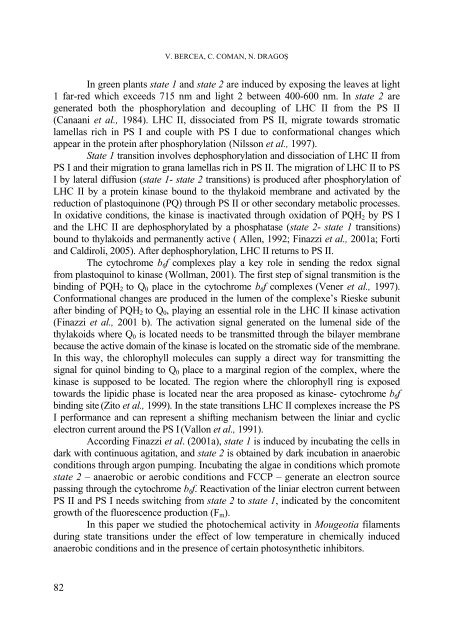biologia - Studia
biologia - Studia
biologia - Studia
Create successful ePaper yourself
Turn your PDF publications into a flip-book with our unique Google optimized e-Paper software.
V. BERCEA, C. COMAN, N. DRAGOŞ<br />
In green plants state 1 and state 2 are induced by exposing the leaves at light<br />
1 far-red which exceeds 715 nm and light 2 between 400-600 nm. In state 2 are<br />
generated both the phosphorylation and decoupling of LHC II from the PS II<br />
(Canaani et al., 1984). LHC II, dissociated from PS II, migrate towards stromatic<br />
lamellas rich in PS I and couple with PS I due to conformational changes which<br />
appear in the protein after phosphorylation (Nilsson et al., 1997).<br />
State 1 transition involves dephosphorylation and dissociation of LHC II from<br />
PS I and their migration to grana lamellas rich in PS II. The migration of LHC II to PS<br />
I by lateral diffusion (state 1- state 2 transitions) is produced after phosphorylation of<br />
LHC II by a protein kinase bound to the thylakoid membrane and activated by the<br />
reduction of plastoquinone (PQ) through PS II or other secondary metabolic processes.<br />
In oxidative conditions, the kinase is inactivated through oxidation of PQH 2 by PS I<br />
and the LHC II are dephosphorylated by a phosphatase (state 2- state 1 transitions)<br />
bound to thylakoids and permanently active ( Allen, 1992; Finazzi et al., 2001a; Forti<br />
and Caldiroli, 2005). After dephosphorylation, LHC II returns to PS II.<br />
The cytochrome b 6 f complexes play a key role in sending the redox signal<br />
from plastoquinol to kinase (Wollman, 2001). The first step of signal transmition is the<br />
binding of PQH 2 to Q 0 place in the cytochrome b 6 f complexes (Vener et al., 1997).<br />
Conformational changes are produced in the lumen of the complexe’s Rieske subunit<br />
after binding of PQH 2 to Q 0 , playing an essential role in the LHC II kinase activation<br />
(Finazzi et al., 2001 b). The activation signal generated on the lumenal side of the<br />
thylakoids where Q 0 is located needs to be transmitted through the bilayer membrane<br />
because the active domain of the kinase is located on the stromatic side of the membrane.<br />
In this way, the chlorophyll molecules can supply a direct way for transmitting the<br />
signal for quinol binding to Q 0 place to a marginal region of the complex, where the<br />
kinase is supposed to be located. The region where the chlorophyll ring is exposed<br />
towards the lipidic phase is located near the area proposed as kinase- cytochrome b 6 f<br />
binding site (Zito et al., 1999). In the state transitions LHC II complexes increase the PS<br />
I performance and can represent a shifting mechanism between the liniar and cyclic<br />
electron current around the PS I (Vallon et al., 1991).<br />
According Finazzi et al. (2001a), state 1 is induced by incubating the cells in<br />
dark with continuous agitation, and state 2 is obtained by dark incubation in anaerobic<br />
conditions through argon pumping. Incubating the algae in conditions which promote<br />
state 2 – anaerobic or aerobic conditions and FCCP – generate an electron source<br />
passing through the cytochrome b 6 f. Reactivation of the liniar electron current between<br />
PS II and PS I needs switching from state 2 to state 1, indicated by the concomitent<br />
growth of the fluorescence production (F m ).<br />
In this paper we studied the photochemical activity in Mougeotia filaments<br />
during state transitions under the effect of low temperature in chemically induced<br />
anaerobic conditions and in the presence of certain photosynthetic inhibitors.<br />
82
















